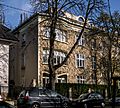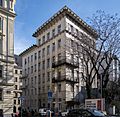Jože Plečnik facts for kids
Quick facts for kids
Jože Plečnik
|
|
|---|---|

Plečnik in 1943
|
|
| Born | 23 January 1872 |
| Died | 7 January 1957 (aged 84) Ljubljana, PR Slovenia, FPR Yugoslavia
|
| Nationality | Slovene |
| Occupation | Architect |
| Buildings | Triple Bridge, Ljubljana, (1929–32) National and University Library (1930–41) Prague Castle (1920–34) |
| Projects | unrealized Slovene Acropolis (Cathedral of Freedom) (1947) |
Jože Plečnik (born January 23, 1872 – died January 7, 1957) was a famous Slovene architect. He made a huge impact on the look of cities like Vienna, Prague, and especially Ljubljana, the capital of Slovenia.
In Ljubljana, he designed many well-known landmarks. These include the amazing Triple Bridge, the important National and University Library of Slovenia building, and the beautiful riverbanks along the Ljubljanica River. He also designed the Ljubljana Central Market, the Ljubljana cemetery, parks, and town squares. People often compare his influence on Ljubljana to how much Antoni Gaudí changed Barcelona.
Plečnik's style is linked to the Vienna Secession movement, which is a type of Art Nouveau art and architecture. Besides Ljubljana, he also worked in Vienna, Belgrade, and on Prague Castle. His ideas even influenced a style called Czech Cubism. He was also one of the first teachers at the Ljubljana School of Architecture, joining after being invited by another famous architect, Ivan Vurnik.
Contents
Life of Jože Plečnik
Plečnik was born in Ljubljana, which was then part of Austria-Hungary (now Slovenia). His parents were Helena and Andrej Plečnik. He studied architecture with a well-known teacher and architect named Otto Wagner in Vienna. Plečnik even worked in Wagner's architecture office until 1900.
Plečnik's Architectural Work
From 1900 to 1910, while working in Vienna, Plečnik designed buildings like the Langer House (1900) and the Zacherlhaus (1903–1905).
His Church of the Holy Spirit (built 1910–1913) is special. It used concrete in a new way, both for the structure and the outside walls. The church's basement, called a crypt, is very unique. It has thin concrete columns with cool, angular shapes at the top and bottom.
In 1911, Plečnik moved to Prague. There, he taught at a college for arts and crafts. Later, in 1920, the first president of the new country of Czechoslovakia, Tomáš Masaryk, asked Plečnik to be the main architect for the renovation of Prague Castle.
From 1920 to 1934, Plečnik worked on many projects at the castle. He redesigned gardens and courtyards. He also created and installed monuments and sculptures. He even designed new rooms inside the castle, like the Plečnik Hall, finished in 1930. This hall has three levels of columns inspired by ancient Greek architecture. His last project in Prague was the Church of the Most Sacred Heart of Our Lord (1929–1932).
In 1921, the Ljubljana School of Architecture was started in his hometown. His friend, architect Ivan Vurnik, invited him to be one of the first teachers. Plečnik moved back to Ljubljana and taught architecture at the University of Ljubljana. He stayed in Ljubljana until he passed away. This is why his work is most famous and visible there.
Shaping Modern Ljubljana
Plečnik truly gave the capital of Slovenia, Ljubljana, its modern look. He designed famous buildings like the National and University Library of Slovenia. He also designed other important buildings, such as the Vzajemna Insurance Company Offices.
He also improved many public spaces in the city. He renovated Ljubljana's bridges and the banks of the Ljubljanica River. He designed the buildings for the Ljubljana Central Market and the Ljubljana cemetery. He also created many parks and public squares. The buildings Plečnik designed were built by a constructor named Matko Curk.
During the time when Slovenia was under Communist rule, Plečnik was not as popular. This was partly because he was a Catholic. His teaching role at the university slowly became smaller because he was over 70 years old.
In 1947, the president of the Slovene People’s Assembly asked him to design a new Parliament building. Plečnik suggested a grand building called the Cathedral of Freedom (also known as the Plečnik Parliament). He wanted to remove the old Ljubljana Castle and build a huge eight-sided building instead.
In 1952, leaders in Ljubljana asked Plečnik to change the Križanke monastery into a place for the Ljubljana Festival. This was his last big project in Ljubljana. He also worked on other projects around this time. These included renovating the Prešeren Theater and designing the Plečnik Arcades, a stairway, and a fountain in Kranj. He also rebuilt churches and designed a pavilion on the Brijuni Islands. He created many monuments for the National Liberation War in different towns.
For all his great work, he received the Prešeren Award twice, in 1949 and 1952. Jože Plečnik passed away in 1957. He had a special state funeral in Žale, attended by many important leaders from politics, culture, and the church.
Plečnik's Legacy
In the 1980s, people became interested in Plečnik's work again. This happened after he was somewhat forgotten in the 1960s and 1970s. Since then, Plečnik's memory has been honored in many ways. In the 1990s, his image was put on the Slovene 500 tolar banknote. The National and University Library of Slovenia building was shown on the other side of the banknote.
The Cathedral of Freedom, which Plečnik designed but was never built, is featured on the Slovene 10 cent euro coin. An album by the Slovene music group Laibach is even titled Slovenska akropola. In August 2008, a small model of the Parliament was shown at an exhibition in Brussels, Belgium. The exhibition was about Plečnik's life and work. The exhibition's curator called the Parliament "the most charismatic object" Plečnik ever designed.
Also, on January 23, 2012, to celebrate 140 years since Plečnik's birth, a picture of the Triple Bridge was used as the official Google logo (Doodle) in Slovenia.
Plečnik's home in Ljubljana is now a museum. It shows his life and all his amazing work. You can also find several statues of him around Ljubljana. They are popular tourist attractions and proud reminders of his important buildings and lasting impact.
Gallery
Work on Prague Castle
See also
 In Spanish: Jože Plečnik para niños
In Spanish: Jože Plečnik para niños

































